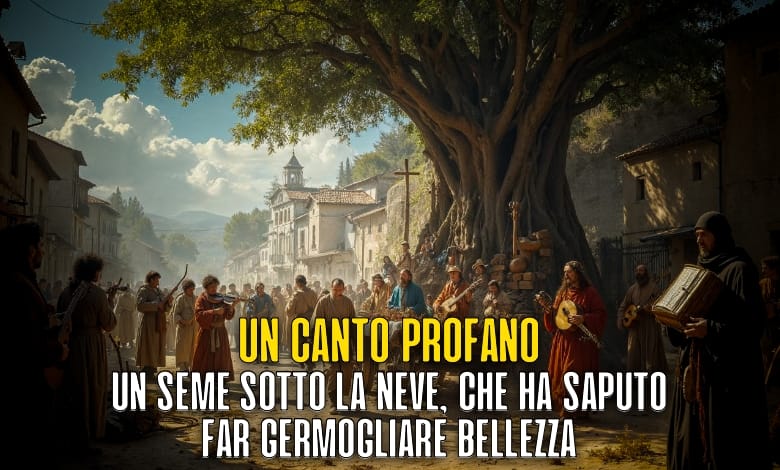Article index
The primitive singers: the evolution of profane music in the Middle Ages
In the Middle Ages, an era wrapped in the mantle of the sacred, the profane music fought to emerge from the shadow of religious devotion.
Imagine a world where every note, every melody, was an offer to the altar of the Divine, where the soul of the people fed on sacred songs and prayers.
However, in this scenario of humble adoration, there was a desire for more human expression, more earthly.
With the passing of the centuries, like a seed that sprouts under the snow, a slow but inexorable evolution began to make its way.
The primitive singers, with their voices and their rudimentary tools, began to intertwine melodies that spoke of loves, adventures, everyday life.
These wandering artists, often despised and banned from the Church, laid the foundations for a new artistic era, where music was no longer only an echo of faith, but an expression of humanity in all its complexity and beauty.
 The origins: ioculatores and jongleurs
The origins: ioculatores and jongleurs
The first manifestations of profane music date back to a period in which Europe was crossed by groups of musician music and histrions.
These street artists, descendants of the ancient Roman ioculatores , spread throughout the continent, particularly stable in the Gauls.
Known as Jongleurs in French, these multifaceted performers included:
- Girms and astrologers
- Ciarlatani and Chiromanti
- dancers and flute players
- singers and comedians
This varied community of artists represented the lowest expression of an opposite trend to dominant religious ideals, which is why it was banned and excommunicated by the Church.
Musical instruments and practices
The primitive singers used a wide range of musical instruments, including:
- Arco tools such as the Fiedel, without a bridge
- flat harmonic tools such as the Ribeba (or Ribeca) with two ropes
- the Viella (Viola ancestor) with five ropes
- breathtaking instruments such as piffers, frames and flutes
These nomadic musicians, although despised by civil society, played an important role in popular life, especially during the numerous parties where there was a need for entertainment.
The evolution of musicians in musicians
Over time, some elements of this class of artists began to progress, preparing the ground for new forms of musical expression. Particularly active outside Italy, these musicians became the custodians of the popular songs, acting as a bridge between the art of the people and that of the courts.
Gradually, the musicians turned into real musicians, gaining respect within the company.
They abandoned nomadic life to settle in fixed places and organized themselves in confraternities and corporations recognized civilly.
The oldest partnerships of this type date back to the thirteenth century, with garments that exercised an effective authority and received titles such as "Prefect", "Marshal" and even "Re" (Rex Histrionum, Roi des Mestriers).
 The first profane compositions of art
The first profane compositions of art
The oldest compositions of profane lyric date back to the IX and X centuries, based on Latin classic texts or on Latin texts of the time.
However, being written in neumatic notation without a line, they are untranslatable for us today.
Among the texts put to music we find:
- Odi of Orazio
- Fragments of the Aeneid of Virgil
- songs of the Tebaide di Stazio
- Parts of the eighth satire of Giovenale
- Celebrations of contemporary facts
Noteworthy are also the profane sequences, often of a cheerful and burlesque character, sung by the Scholae students.
New musical forms in the twelfth century
In the twelfth century two particularly significant musical forms emerge:
1. The Latin Monodo 2 conductus
2. The monodic conductus, which developed parallel to the polyphonic conductus
These forms represent an important step forward in the evolution of profane music, demonstrating a growing sophistication and variety in the compositions.
From the shade to light: the rise of profane music in the Middle Ages
Starting from the points previously described, the evolution of primitive singers and profane music in the Middle Ages is a fascinating journey that winds through the shadows of marginality until we reach the light of social and artistic gratitude.
These wandering musicians, with their simple but evocative melodies, have embarked on a tortuous path, marked by initial difficulties and the opposition of the Church, which saw in their art a threat to their spiritual authority.
Imagine the medieval roads, dusty and crowded, where the singers, with their rudimentary instruments, performed for a varied audience, made up of farmers, merchants and nobles.
Their voices, often accompanied by louts, flutes and drums, resonated as an echo of freedom in an era dominated by the rigidity of the liturgy.
Despite criticisms and prohibitions, these itinerant artists did not stop; Their music, like a seed laid in a fertile ground, began to sprout, laying the foundations for the development of new musical forms.
Their persistence and adaptability were the keys that allowed the profane music to emerge from the shadow of the dominant religious culture.
Each note, every melody, was an act of rebellion and creativity, an attempt to express the complexity of the human soul beyond the rigid ecclesiastical structures.
Their songs, often stories of loves, adventures and daily life, offered a lively and colorful contrast to the monotony of sacred songs.
Over time, this music found its space, opening the way to new artistic expressions that would bloom in the following centuries.
The melodies of the primitive singers, like flowers that bloom in a garden, brought freshness and variety to the music scene of the time, deeply influencing the history of western music.
Every note, every agreement, was a step towards a new era, where music was no longer only an echo of faith, but an expression of humanity in all its complexity and beauty.
[Divider Style = "Solid" Top = "20 ″ Bottom =" 20 ″]
Read also the article: the singing that unites: a sound journey from global peace to millenary traditions
[Divider Style = "Solid" Top = "20 ″ Bottom =" 20 ″]
Download the exclusive dispensation for SIING PLUS subscribers
Log in to the exclusive SIING PLUS material
Or support us
Plus
Newsletter Siing Plus
Facebook private group
Private telegram
Private group WhatsApp
20%
discounts on all products and events organized by
Siing Production and Solos MediaAccess to all articles of the 7 platform planets
Access to all video courses, handouts, tutorials
4 numbers of the online magazine Siing Magazine 2025
Plus
Newsletter Siing Plus
Facebook private group
Private telegram
Private group WhatsApp
20%
discounts on all products and events organized by
Siing Production and Solos MediaAccess to all articles of the 7 platform planets
Access to all video courses, handouts, tutorials








